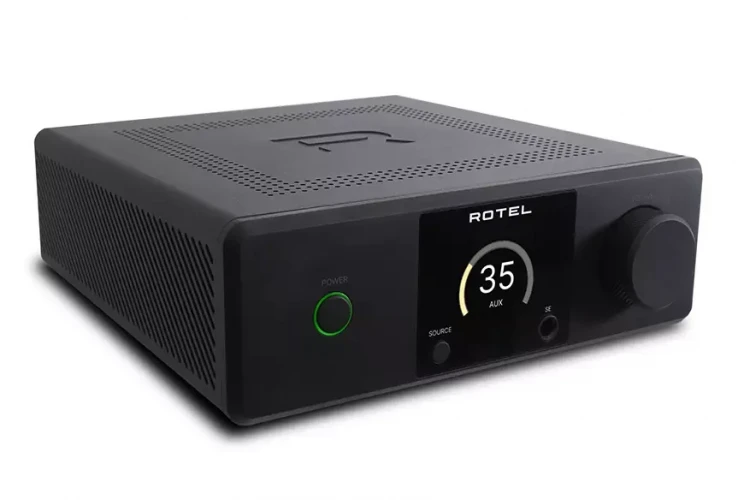
Goldmund Rhea and Theia are Now Available in Passive Versions
25.04.2025 07:31 | ~1 minute read
Last year, Goldmund launched the impressive Goldmund Rhea and Theia acoustics in active versions with a wireless streamer. The all-in-one solution certainly looked brilliant, but High-End fans often prefer component systems. So now the company has introduced the Goldmund Rhea and Theia loudspeakers in a Passive version.
The considerable weight of the Goldmund Theia Passive and Rhea Passive speakers (123 and 197 kg respectively) in combination with Goldmund's patented mechanical grounding system diverts cabinet vibrations to the ground through a precisely defined point. The company claims that this approach ensures a clean, uncolored sound.

The advanced crossover design ensures seamless integration of the driver areas of responsibility, creating a wide, immersive soundstage with precise balance and dispersion. Each driver has its own crossover board, made with high-quality components such as MKP capacitors and non-inductive film resistors, and equipped with special heatsinks to maintain performance in difficult conditions, even if the temperature rises slightly.

The Goldmund Rhea Passive is a passive three-way speaker system equipped with a soft dome tweeter, one 7” midrange driver and a 12” woofer. The larger Goldmund Theia Passive uses a four-way design with a soft dome tweeter, two midrange drivers (one 4” and one 6”) and a 12” woofer.
The declared working frequency range of the Goldmund Rhea Passive model is from 27 Hz to 25 kHz. The lower limit of the range of the older Theia Passive model is 20 Hz, which is ideal for human hearing.
Specifications
This product is in the Hi-Fi and High End Electronics and Acoustics database
Floorstanding loudspeakers — Goldmund Rhea Passive
Model name
Rhea Passive
Frequency Response low +/- 3dB (Hz)
27
Frequency Response high +/- 3dB (Hz)
25 000
Sensitivity (dB at 1 W/1m)
N/A
Impedance (Ohms)
6
Power amplifier requirements (W)
N/A
Has internal amplification
N/A
Internal amplification power (W)
N/A
Size (sm)
45 × 135 × 54
Weight (kg)
123
Official link
Specifications
This product is in the Hi-Fi and High End Electronics and Acoustics database
Floorstanding loudspeakers — Goldmund Theia Passive
Model name
Theia Passive
Frequency Response low +/- 3dB (Hz)
20
Frequency Response high +/- 3dB (Hz)
25 000
Sensitivity (dB at 1 W/1m)
N/A
Impedance (Ohms)
6
Power amplifier requirements (W)
N/A
Has internal amplification
N/A
Internal amplification power (W)
N/A
Size (sm)
55 × 158 × 67.5
Weight (kg)
197
Official link
More content

Stratton Acoustics Element 6 and Element 8 – Acoustics with Patented Tweeters
Stratton Acoustics has introduced two models of compact bookshelf loudspeakers – Element 6 and Element 8. Both speakers use the company’s patented soft dome tweeters with a diameter of 29 mm, equipped with a waveguide to provide wide sound dispersion. The models are hand-assembled at the company’s own factory in England.

SMSL VMV A1 Pro - Integrated Amplifier on GaN FET Transistors
The SMSL company presented the SMSL VMV A1 Pro power amplifier - using lnfineon's latest GaN FET transistors, with a switching frequency of up to 1 MHz. Such unique circuitry guarantees, according to the company, absolutely natural sound and up to 400 W of output power.

Treehaus Audiolab LCR Phono – a Vacuum Tube Phonostage with Passive Equalization
Treehaus Audiolab has announced the Treehaus Audiolab LCR Phono reference vacuum tube phono preamplifier. To equalize the signal, the device uses only passive components: inductors (L), capacitors (C) and resistors (R).

Rotel DX-5 – a Tiny Amplifier Operating in Class A/B
Rotel DX-5 is a compact model, but despite its dimensions, the device does not use digital amplification and operates in class A/B, reaching 2 x 33 W into 4 Ohm load and 2 x 25 W into 8 Ohm speakers. The new product is equipped with a power supply based on a powerful toroidal transformer created by Rotel itself, and high-current transistors.

TOTALDAC d1-total – a Fully “Packed” DAC and Streamer
The Totaldac d1-total digital-to-analog converter has been introduced – according to the company, this device guarantees the maximum possible for a single-block design with external PSU. “Under the hood”, in addition to the d1-triunity DAC converter, there is also volume control, a network streamer (latest version developed for the d1-streamer-live), 40 femtoseconds oscillators, a microfilter USB loop (developed for the d1-streamer-live) and anti-vibration supports.


